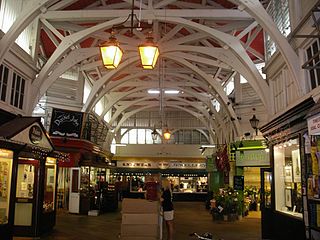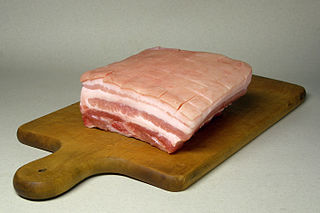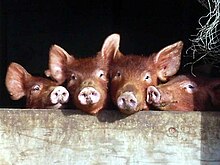
A sausage is a type of meat product usually made from ground meat—often pork, beef, or poultry—along with salt, spices and other flavourings. Other ingredients, such as grains or breadcrumbs may be included as fillers or extenders.

Head cheese or brawn is a cold cut terrine or meat jelly that originated in Europe. It is made with flesh from the head of a calf or pig, typically set in aspic, and usually eaten cold, at room temperature, or in a sandwich. Despite its name the dish is not a cheese and contains no dairy products. The parts of the head used vary, and may include the tongue and sometimes the feet and heart but do not commonly include the brain, eyes or ears. Trimmings from more commonly eaten cuts of pork and veal are often used, with gelatin added as a binder.

Hungarian or Magyar cuisine is the cuisine characteristic of the nation of Hungary, and its primary ethnic group, the Magyars. Hungarian cuisine has been described as being the spiciest cuisine in Europe. This can largely be attributed to the use of their piquant native spice, Hungarian paprika, in many of their dishes. A mild version of the spice, Hungarian sweet paprika, is commonly used as an alternative. Traditional Hungarian dishes are primarily based on meats, seasonal vegetables, fruits, bread, and dairy products.

Pudding is a type of food. It can be either a dessert, served after the main meal, or a savoury dish, served as part of the main meal.

A blood sausage is a sausage filled with blood that is cooked or dried and mixed with a filler until it is thick enough to solidify when cooled. Most commonly, the blood of pigs, sheep, lamb, cow, chicken, or goose is used.

Offal, also called variety meats, pluck or organ meats, is the internal organs of a butchered animal. The word does not refer to a particular list of edible organs, and these lists of organs vary with culture and region, but usually exclude skeletal muscle. Offal may also refer to the by-products of milled grains, such as corn or wheat.

A butcher is a person who may slaughter animals, dress their flesh, sell their meat, or participate within any combination of these three tasks. They may prepare standard cuts of meat and poultry for sale in retail or wholesale food establishments. A butcher may be employed by supermarkets, grocery stores, butcher shops and fish markets, slaughter houses, or may be self-employed.

The Covered Market is a historic market with permanent stalls and shops in a large covered structure in central Oxford, England.

Rookworst or Gelderse rookworst is a type of Dutch sausage in which ground meat is mixed with spices and salt and stuffed into a casing. Having the shape of a Bologna sausage, it is common in the Netherlands and is also exported to Great Britain. The basis for Gelderse rookworst is metworst, or lean pork. Traditionally, rookworst is made with pork, stuffed in a small pig intestine and smoked over smouldering oak- and beechwood chips. This traditional rookworst is usually sold in butcher shops.

Roughley is an electoral ward within the Royal Town of Sutton Coldfield, and is the most northerly part of the administrative area covered by the Royal Sutton Coldfield Town Council and the City of Birmingham. Over half of Roughley Ward is attractive Green Belt countryside, including arable and dairy farms, historic field boundaries survive with mature hedgerows and woodlands. Several public footpaths provide access to the countryside and the one linking Hillwood Road and Dale Farm provides distant views of Lichfield Cathedral and on a clear day the Pennine Hills.

The Gourmet Ghetto is a colloquial name for the business district of the North Berkeley neighborhood in the city of Berkeley, California, known as the birthplace of California cuisine. Other developments that can be traced to this neighborhood include specialty coffee, the farm-to-table and local food movements, the rise to popularity in the U.S. of chocolate truffles and baguettes, the popularization of the premium restaurant designed around an open kitchen, and the California pizza made with local produce. After coalescing in the mid-1970s as a culinary destination, the neighborhood received its "Gourmet Ghetto" nickname in the late 1970s from comedian Darryl Henriques. Early, founding influences were Peet's Coffee, Chez Panisse and the Cheese Board Collective. Alice Medrich began her chain of Cocolat chocolate stores there.
Peter Kindersley is the co-founder of the publishing company Dorling Kindersley and ran it with Christopher Dorling from 1974, until he sold his family stake for £105m in 2000. The firm's illustrated non-fiction reference books for adults and children are marketed globally and translated into other languages.

Sugar Mountain Farm is a 70 acres (28 ha) family-operated pig farm in West Topsham, Vermont with approximately 200-400 pastured-raised pigs. The pigs are fed acid whey from a nearby dairy farm, apple pomace leftovers from a nearby cider facility, vegetables, and spent barley from a brewery as opposed to grain.

Pig slaughter is the work of slaughtering domestic pigs to obtain pig meat (pork). It regularly happens as part of traditional and intensive pig farming. which is both a common economic activity as well as a traditional feast in some European and Asian countries.

Pork is the culinary name for the meat of the pig. It is the most commonly consumed meat worldwide, with evidence of pig husbandry dating back to 5000 BCE.
Pork in Ireland has been a key part of the Irish diet since prehistory. Ireland's flora and fauna overwhelmingly arrived via a Neolithic land bridge from Great Britain prior to its submerging around 12,000 BP. When the very first hunter-gatherers arrived around 2,000 years later, the local ecosystem largely resembled that of modern Ireland.
The Duchy Home Farm is an organic farm operated by the Duchy of Cornwall. The farm is part of the gardens of Highgrove House, the country home of King Charles III. The produce is used as ingredients in Duchy Originals products, sold in vegetable boxes, and wholesaled to supermarkets and restaurants. King Charles is credited with using "pioneering agriculture techniques" to produce this organic food.
The coast of Ceredigion is made up of a long coastal plain that contains high cliffs, coves, large bays and estuaries. The coastal plain gets narrower towards the more mountainous north of the county and is cut by the wide estuaries of the Teifi and the Dyfi. The broad and fertile Teifi valley is ideal for dairy farming and mixed farming. Heavy rainfall washes the minerals out of the soil and results in the mountainous areas of the county having relatively poorer, acidic soils. The plough line can be as low as 700 feet, which restricts cultivation.















